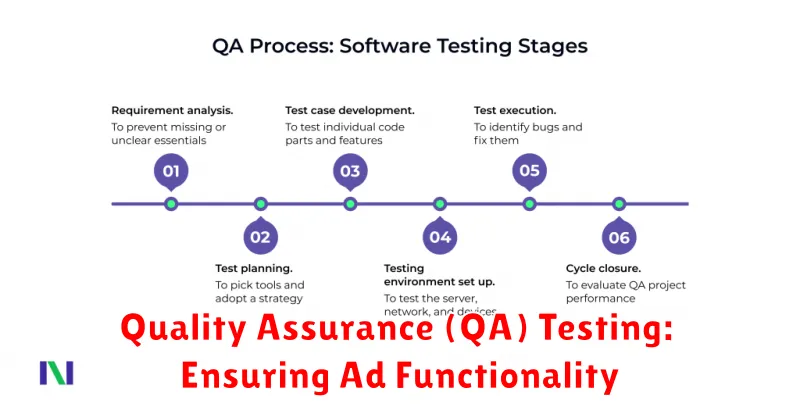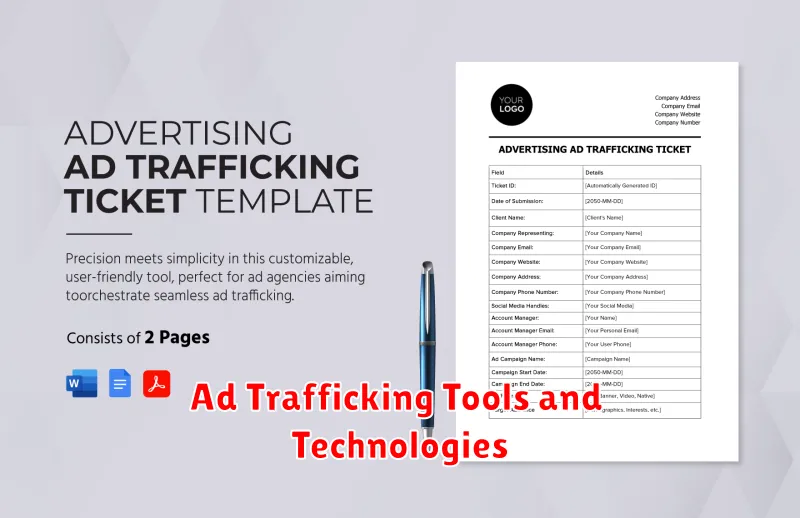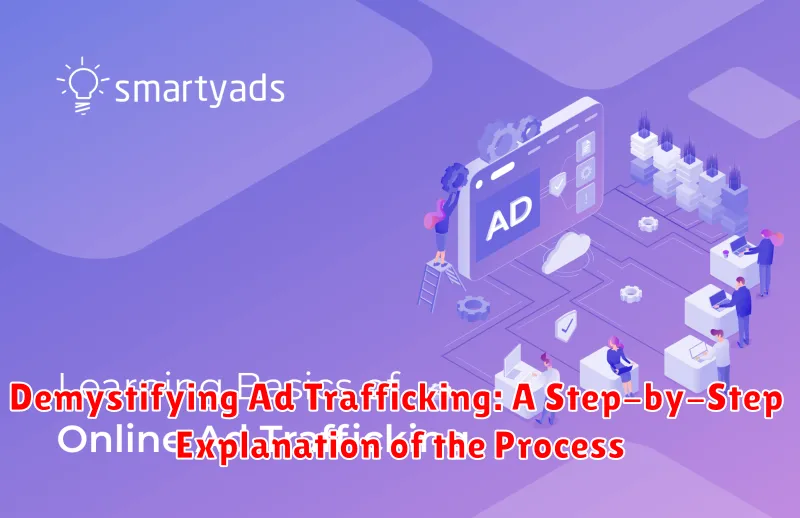Are you looking to understand the intricate world of online advertising? Then look no further. This article, “Demystifying Ad Trafficking: A Step-by-Step Explanation of the Process,” offers a comprehensive guide to ad trafficking, a critical process in the digital advertising ecosystem. We aim to break down the complex terminology and procedures, providing clarity on how digital ads are delivered, managed, and optimized across various platforms. Whether you are a seasoned marketing professional or simply curious about the mechanics behind the ads you see online, this guide is designed to provide a foundational understanding of ad operations and its core components.
In the following sections, we will walk you through each step of the ad trafficking process, from initial ad creative development to final campaign reporting. We will explore the roles of key players such as ad servers, publishers, and advertisers, and the importance of elements like ad tags and tracking pixels. We will shed light on how ad campaigns are configured, monitored, and adjusted to ensure optimal performance and reach the desired target audience. By the end of this step-by-step explanation, you will have a solid grasp of how digital advertising works behind the scenes, enabling you to make informed decisions and navigate the digital landscape with confidence.
What is Ad Trafficking?
Ad trafficking is the process of managing and implementing digital advertising campaigns. It involves the logistical and technical steps necessary to ensure that advertisements are displayed correctly to the intended audience, at the right time, and on the appropriate websites or applications.
At its core, ad trafficking is about taking the creative assets provided by advertisers and setting them up within an ad server, a specialized platform designed to manage and deliver online advertising. This includes configuring campaign parameters like:
- Targeting criteria (e.g., demographics, interests, geography)
- Scheduling (start and end dates/times)
- Budget allocation
- Frequency capping (limiting the number of times a user sees an ad)
The process also encompasses generating tracking URLs, implementing ad tags on publisher websites, and continuously monitoring campaign performance to optimize for the best results. Effective ad trafficking is crucial for maximizing the impact and efficiency of digital advertising investments.
Key Roles and Responsibilities in the Ad Trafficking Process
Effective ad trafficking relies on a collaborative effort from various team members, each with distinct responsibilities. Understanding these roles is crucial for a smooth and successful campaign launch.
Key Roles:
- Ad Operations Manager: Oversees the entire ad trafficking process, ensuring campaigns are set up correctly and launched on time. This role often involves managing the ad trafficking team and establishing best practices.
- Ad Trafficker: The primary individual responsible for implementing the campaign within the ad server. This includes setting up line items, uploading creatives, and generating tracking URLs.
- Media Planner/Buyer: Determines the target audience, selects appropriate websites or platforms, and negotiates pricing for ad placements. They provide the ad trafficker with the campaign parameters.
- Creative Team: Develops the ad creatives (banners, videos, etc.) and provides them to the ad trafficker in the correct formats and sizes.
- Account Manager: Acts as the liaison between the client and the internal team, ensuring the campaign meets the client’s objectives.
Each role is integral to the overall success of the campaign. Clear communication and a well-defined workflow are essential for minimizing errors and maximizing efficiency.
The Initial Steps: Campaign Setup and Creative Submission
The ad trafficking process commences with meticulous campaign setup. This stage involves defining the campaign’s objectives, target audience, budget allocation, and flight dates. Detailed specifications are crucial to ensure the campaign aligns with the advertiser’s goals.
Simultaneously, the creative submission process unfolds. Advertisers provide the creative assets, which may include banner ads, video ads, or rich media formats. These assets must adhere to specific size, format, and file size requirements stipulated by the publisher or ad network.
Key considerations during this phase include:
- Ensuring all creative assets meet technical specifications.
- Verifying that creative assets align with brand guidelines and legal regulations.
- Implementing a clear naming convention for all campaign elements.
Accurate and timely completion of these initial steps is paramount for a seamless ad trafficking workflow.
Ad Server Configuration: Setting Up the Campaign in the Ad Server
The core of ad trafficking involves precise ad server configuration. This stage is where the campaign parameters, previously defined, are translated into concrete settings within the ad server’s interface.
Key steps include:
- Campaign Creation: Defining the campaign name, start and end dates, and overall budget.
- Ad Group Setup: Organizing ads into groups based on targeting criteria or creative type.
- Targeting Implementation: Specifying the audience segments, geographic locations, devices, and other relevant targeting parameters.
- Creative Upload: Uploading the approved ad creatives in the required formats (e.g., HTML5, image, video).
- Pricing and Bidding: Setting the appropriate pricing model (CPM, CPC, etc.) and bid values.
- Frequency Capping: Implementing limits on the number of times a user sees an ad.
Accurate and thorough configuration is crucial for ensuring that ads are delivered to the intended audience, within budget, and according to the campaign objectives. Failure to configure the ad server correctly can result in wasted impressions, poor performance, and inaccurate reporting.
Quality Assurance (QA) Testing: Ensuring Ad Functionality

Quality Assurance (QA) testing is a crucial phase in the ad trafficking process, ensuring that all ad creatives function correctly and meet campaign specifications before going live. This meticulous testing helps prevent costly errors and ensures a smooth user experience.
The primary goal of QA is to verify that the ads are displaying as intended, that click-through URLs are accurate, and that tracking mechanisms are properly implemented. This involves a comprehensive review of the ad creative across different browsers, devices, and operating systems.
Key Aspects of QA Testing:
- Creative Rendering: Ensuring the ad displays correctly, with no broken images or misaligned elements.
- Click-Through URL Verification: Confirming that the click-through URL leads to the correct landing page.
- Tracking Implementation: Validating that impression and click trackers are firing accurately.
- Browser and Device Compatibility: Testing the ad’s functionality across various browsers (Chrome, Firefox, Safari, etc.) and devices (desktops, tablets, smartphones).
Thorough QA testing is vital for campaign success, as it identifies and resolves potential issues early in the process.
Generating Tracking URLs and Implementing Tags
The generation of tracking URLs and the subsequent implementation of tags are crucial steps in monitoring and attributing the success of digital advertising campaigns. Tracking URLs, also known as click trackers or impression trackers, are specifically designed to capture data related to user interactions with ads.
Generating Tracking URLs: This process involves creating unique URLs for each ad placement. These URLs typically contain parameters that allow for the identification of the campaign, ad group, creative, and publisher. Ad servers or specialized tracking platforms are used to automatically generate these URLs.
Implementing Tags: Once the tracking URLs are generated, they must be implemented correctly within the ad creatives and the publisher’s website. This involves embedding the tracking URLs within the ad’s code or using HTML tags, such as <img> tags or JavaScript tags, to fire tracking pixels when an ad is displayed or clicked. Proper implementation ensures accurate data collection and reporting. Common tag types include:
- Click Tags: Track clicks on ads.
- Impression Tags: Track ad impressions (views).
- Conversion Tags: Track desired user actions after clicking an ad (e.g., purchases, sign-ups).
Ad Trafficking Workflow: A Detailed Look
The ad trafficking workflow involves a series of steps executed to ensure the proper delivery of online advertisements. Understanding this flow is crucial for efficient campaign management.
Key Stages in the Workflow:
- Campaign Initiation: Receiving campaign details and assets from the media planning team.
- Ad Server Setup: Configuring the campaign within the ad server, including targeting criteria and flight dates.
- Creative Upload and Association: Uploading ad creatives and associating them with the appropriate line items.
- Tag Generation and Implementation: Generating tracking URLs and providing them to the publisher for placement.
- QA Testing: Thoroughly testing ad functionality across various browsers and devices.
- Monitoring and Optimization: Continuously monitoring campaign performance and making necessary adjustments.
Effective communication between the trafficker, media planners, and publishers is vital throughout this workflow. Clear documentation and standardized processes help minimize errors and ensure smooth campaign execution.
Troubleshooting Common Ad Trafficking Issues
Even with meticulous planning, ad trafficking can encounter unforeseen issues. Swift and accurate troubleshooting is crucial for campaign success. This section outlines common problems and effective solutions.
Common Issues and Solutions:
- Incorrect Creative Dimensions: Verify creative specifications against the ad server’s requirements. Resize or adjust creatives as needed.
- Click-Through URL Errors: Double-check the accuracy of all click-through URLs. Use URL encoding to prevent issues with special characters.
- Tracking Pixel Discrepancies: Ensure tracking pixels are correctly implemented and firing properly. Use browser developer tools to inspect network requests.
- Ad Server Discrepancies: Investigate discrepancies between the ad server and third-party reporting. Confirm accurate tag implementation and data synchronization.
- Geographic Targeting Problems: Verify that geographic targeting settings are correctly configured in the ad server. Test with proxy servers to confirm ad delivery in the intended locations.
When encountering issues, systematically isolate the problem. Examine each component of the ad setup, from creative assets to tracking tags, to identify the root cause.
Best Practices for Efficient Ad Trafficking
To ensure efficient ad trafficking and minimize errors, adhering to best practices is paramount. These practices streamline the process, reduce discrepancies, and optimize campaign performance.
- Standardize Naming Conventions: Implement a consistent and logical naming convention for all campaign elements (ads, creatives, placements). This enhances organization and simplifies reporting.
- Maintain a Centralized Asset Library: Establish a repository for all creative assets, ensuring easy access and version control.
- Thoroughly Review Insertion Orders (IOs): Carefully examine IOs for accuracy, including targeting parameters, flight dates, and budget allocations.
- Implement a Robust QA Process: Conduct rigorous quality assurance testing before launching any campaign to identify and resolve potential issues.
- Utilize Ad Server Features: Leverage ad server functionalities like automated reporting, creative rotation, and frequency capping to optimize campaign delivery.
- Document Everything: Maintain detailed documentation of all campaign setup procedures, including targeting criteria, creative specifications, and tracking parameters.
Ad Trafficking Tools and Technologies

The efficient execution of ad trafficking relies heavily on a suite of specialized tools and technologies. These solutions streamline the process, enhance accuracy, and provide critical insights into campaign performance.
Key Categories of Tools:
- Ad Servers: Platforms like Google Ad Manager, Adform, and Xandr are central hubs for managing and delivering digital advertising campaigns. They offer features for targeting, scheduling, reporting, and optimization.
- Tag Management Systems (TMS): Tools such as Google Tag Manager and Tealium streamline the process of deploying and managing tracking tags without requiring direct code modifications on the website.
- Creative Management Platforms (CMPs): These platforms, like Celtra and Sizmek (now part of Amazon), help manage and optimize creative assets, ensuring consistent branding and effective messaging.
- Verification and Viewability Tools: Companies like DoubleVerify and Integral Ad Science offer solutions to ensure ads are served in brand-safe environments and are actually viewed by users.
- Analytics Platforms: Tools like Google Analytics and Adobe Analytics provide comprehensive data on user behavior and campaign performance, aiding in optimization efforts.
The selection and integration of these tools are crucial for successful ad trafficking and overall campaign success.

